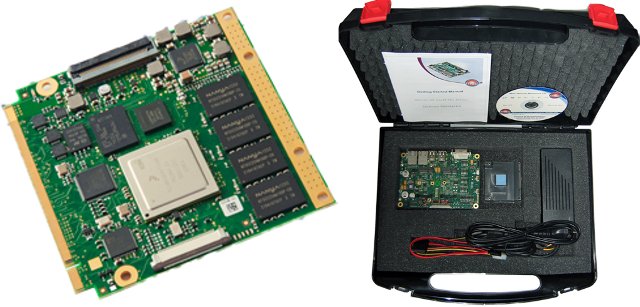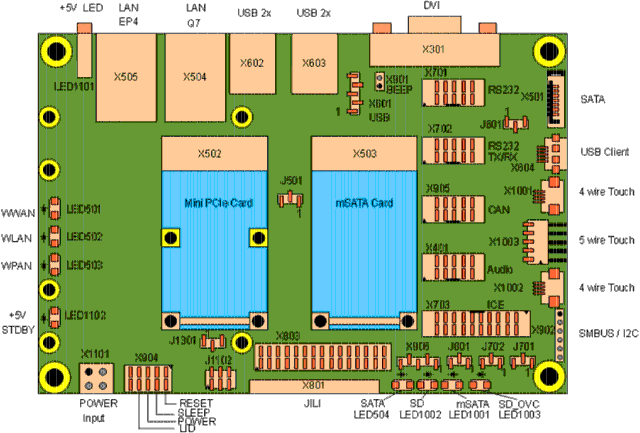MSC Embedded, a company specialized in the design and manufacturing of embedded boards, has recently announced MSC Q7-MB-EP4, a complete Starterkit for the company’s Qseven modules based on Freescale i.MX6 Solo, Dual or Quad processors.

The starter kit comes with a suitcase comprise of a heatspreader with heatsink, a 12V power supply, a cable kit (SATA data and power cable), a DVD, a getting started guide, and more importantly a 3.5″ Qseven carrier board (Q7-MB-EP4) with socket for Qseven modules Rev. 1.20 with the following specifications:
- CPU Module Interface – Socket for Qseven Rev. 1.20 compatible modules based on the Freescale i.MX6
- Storage – 1x SATA connector + mSATA Socket with support for mSATA and mSATAmini cards, MMC/SD Card, and serial EEPROM for EPI/DP extensions
- Standard Interfaces:
- 7x USB 2.0: 4x USB (Series-A Jack), 1x USB internal pin header, USB on mini USB connector, USB at Mini PCI Express socket
- RS-232C on pin header driven by the on-board USB-to-RS232 converter (FT232RL)
- ARM RS232 debug port routed to the Qseven module
- CAN Bus signals on on-board pin header
- Socket for one Mini PCI Express module with USB
- Audio Interface – AC’97 Audio with all Audio signals on pin header
- Flat Panel / CRT Interface
- Graphics – DVI connector, max. resolution depending on module
- LCD Interface – LVDS interface on Jili30 connector, EEPROM to store display data, Backlight connector (3.3/5/12V power and DIM signal)
- Miscellaneous – Power Button, Reset, Beeper
- LAN Interface
- One RJ45 connector with LEDs from Qseven module
- One RJ45 connector with LEDs for PCIe-connected GbE LAN
- Controller on board of the Q7-MB-EP4
- Touch Controller – Resistive touch controller for 4/5-wire touch screens; three different touch connectors for 4- and 5-wire touch screens
- Heatrail mounted on Q7-MB-EP4 and Heatspreader
- Power Supply – 110-230V AC to 12V DC with cable kit connecting to 4 pin ATX style power connector on Q7-MB-EP4 baseboard; features an additional disk drive power connector usable for the SATA cable supplied.
- Temperature range – 0º to +60º C operating, -25º to 85º C storage
- Humidity – 20 to 80% operating, 5 to 95% storage (non condensing)
- Dimensions – 148 mm x 102mm
An 8 GB SD card pre-installed with Linux (Yocto0based) is also provided. An optional 12.1″ XGA (1024×768) TFT kit is also available.

One important thing is however missing in the Starter Kit: the CPU module. You’ll have to order separately it because the company offers 8 variations of their Q7-IMX6 SoM with Freescale i.MX6 Solo, Dual or Quad, different temperature ranges (commercial and extended), and SoM with 4GB flash or no flash.
MSC Q7-IMX6 system-on-modules share the following key features:
- SoC – Freescale i.MX6 ARM Cortex-A9 quad-core, dual-core or single-core CPU
- System Memory – up to 4GB DDR3 DRAM
- Storage – up to 32GB eMMC Flash Memory
- Video Output – HDMI graphics 1920 x 1080 x 30fps, Dual-channel LVDS 1920 x 1080 x 30fps (also usable as two sep. LVDS channels)
- Video – MPEG-4 Video Encoding/Decoding 1080p
- Interfaces:
- 10/100/1000 GbE LAN Interface
- 1x PCI-Express x1
- 1x SATA-II (3Gbps, quad-/dual-core only)
- 1x USB Device/Host + up to 7x USB 2.0
- MMC / SD / SDIO Interface
- 1x CAN Interface
- AC’97 and I2S Audio Interface
- UART, SPI, BT.656 Camera, MIPI_CSI-2
- Power Supply Voltage – +5V +/-5%, 5V Standby
- Power Consumption – 4-6 W typ. (depending on CPU and optional features)
- Operating Temperature range – 0º to +70º C commercial, -40º to 85º C extended
The company can provides BSPs (board support packages) for Linux, Android (Work in progress), and Windows Embedded Compact 7.
The MSC Q7-SK-IMX6-IP4 starter kit is available now for $275, Qseven module are also available, but price has not been disclosed. You can find more information on MSC Embedded’s Q7-SK-IMX6-EP4 Starter Kit and Q7-IMX6 SoM pages, although most of the documentation including user’s manuals, mechanical drawings, and the BSPs require a free registration (to be approved by an administrator).
Via LinuxGizmos and Embedded.com

Jean-Luc started CNX Software in 2010 as a part-time endeavor, before quitting his job as a software engineering manager, and starting to write daily news, and reviews full time later in 2011.
Support CNX Software! Donate via cryptocurrencies, become a Patron on Patreon, or purchase goods on Amazon or Aliexpress




